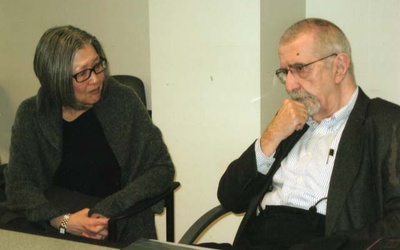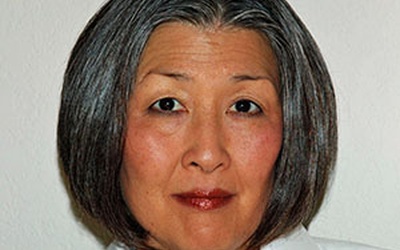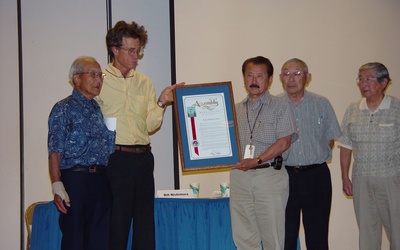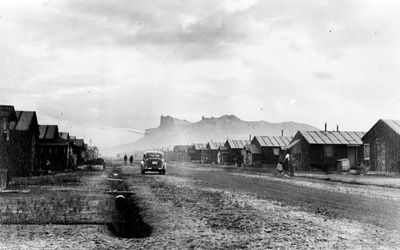
Barbara Takei
@barbaratakeiBarbara Takei is a Detroit-born Sansei whose introduction to the Asian American movement in the late 60s was Grace Lee Boggs and the Detroit Asian Political Alliance. She puzzled over the missing stories of Japanese American dissent against the unjust incarceration for decades, but it wasn’t until her first Tule Lake pilgrimage in 2000 that she realized peaceful protest during WWII was erased by demonizing it as “pro-Japan disloyalty.” For the past two decades, she has served as an officer on the non-profit Tule Lake Committee and devoted herself to preserving Tule Lake as the site of Japanese American civil rights resistance.
Updated January 2023
Stories from This Author
Remembering Roger Daniels
Jan. 29, 2023 • Barbara Takei
The first book I read about Japanese American history was Roger Daniels’ book, “The Politics of Prejudice.” It was 1966, and in my research as a college freshman, it was the rare book on Japanese American history, one that began Roger’s long and illustrious career as a historian documenting the story of Japanese Americans and the wartime incarceration. Over the next half century, Roger’s scholarship was the bedrock of Japanese American historical research. It wasn’t until February 2010 that we …
Does Terminology Matter?
June 3, 2013 • Barbara Takei
In recent years, the Nikkei community has engaged in a renewed discussion to reject the euphemistic and false terms the government used to minimize the unjust and inhumane nature of the Japanese American incarceration. From 2009 through 2011, the Japanese American National Museum, the Manzanar Committee, the Tule Lake Committee, and UCLA’s George & Sakaye Aratani Chair in Japanese American Incarceration, Redress, and Community organized workshops and community-wide symposiums in Southern and Northern California to stimulate discussion and develop consensus …
Legalizing Detention: Segregated Japanese Americans and the Justice Department’s Renunciation Program - Part 9 of 9
May 10, 2013 • Barbara Takei
Read Part 8 >> The government pursued a hard line, determined to challenge the bid of each renunciant who sought restoration of citizenship. In bleak contrast to Goodman’s decision to restore citizenship en masse, the DOJ began sorting renunciants into 22 categories of offenses it characterized as serious enough to deny restoration of citizenship.1 Collins wound up spending many years battling the negative administrative classifications the DOJ assigned to his thousands of individual clients. Collins faced opposition not only from the …
Legalizing Detention: Segregated Japanese Americans and the Justice Department’s Renunciation Program - Part 8 of 9
May 3, 2013 • Barbara Takei
Read Part 7 >> Creating Alien Enemies Edward Ennis’ Deputy in the DOJ Alien Enemy Control Unit, John Burling, was the designated hearing officer for the renunciation hearings at Tule Lake. Burling said that the renunciation hearings would be a careful, deliberate process, making it difficult to renounce. Instead, the DOJ set up what amounted to a deportation mill, stripping Americans of their citizenship and providing the government with a legal fig-leaf that justified the individual detentions. Burling even recommended “accepting these …
Legalizing Detention: Segregated Japanese Americans and the Justice Department’s Renunciation Program - Part 7 of 9
April 26, 2013 • Barbara Takei
Read Part 6 >> Why Did They Renounce? After its publication in 1946, The Spoilage remained for many decades the primary source on Tule Lake. This seminal work cited allegations of harassment by pro-Japan groups that led to the mass renunciations, using field notes written after the war ended, September 25, 1945 and December 19, 1945.1 Renunciants who sought to regain their U.S. citizenship from the Department of Justice recognized that the desired explanation for their renunciation was to blame the pro-Japan …
Legalizing Detention: Segregated Japanese Americans and the Justice Department’s Renunciation Program - Part 6 of 9
April 19, 2013 • Barbara Takei
Read Part 5 >> Stampede to Renounce Public Law 405, authored by U.S. Attorney General Francis Biddle, permitted American citizens to renounce their citizenship during time of war. Congress passed it and President Roosevelt signed it into law on July 1, 1944. This denationalization law was directed at the Japanese Americans in Tule Lake after widespread newspaper coverage of the November 1943 disturbances at Tule Lake led to “intensification of the idea that some law should be passed depriving these people of …
Legalizing Detention: Segregated Japanese Americans and the Justice Department’s Renunciation Program - Part 5 of 9
April 12, 2013 • Barbara Takei
Read Part 4 >> Western Defense Command Preparation for Individual Detention On December 17, 1944, Major General H. C. Pratt, Commander, WDC, rescinded the Mass Exclusion Order that ordered all Japanese Americans removed from the West Coast. Effective January 2, 1945, individual disloyalty, instead of race, would be used as the test for exclusion from the Pacific States. It also provided that “any person of Japanese ancestry about whom there is available information indicating disloyalty will continue to be excluded on an …
Legalizing Detention: Segregated Japanese Americans and the Justice Department’s Renunciation Program - Part 4 of 9
April 5, 2013 • Barbara Takei
Read Part 3 >>End of Army OccupationThe WRA and the Army had very different organizational dynamics, and their relationship was often tense and fraught with disagreement. Conflict over management of the stockade climaxed on May 23, 1944, when the WRA’s Board of Inquiry approved the release of two inmates, while the Army disapproved their release. After a conference between WRA and Army officials on May 24, 1944, Director Best, by letter to Lt. Col. Verne Austin, Commander, 752nd Military Police …
Legalizing Detention: Segregated Japanese Americans and the Justice Department’s Renunciation Program - Part 3 of 9
March 29, 2013 • Barbara Takei
Read Part 2 >> The Stockade: Symbol of the Worthlessness of U.S. CitizenshipWith the Center’s elected leaders imprisoned in the stockade, the stockade became the omnipresent reminder of the keepers’ arbitrary use of power at Tule Lake. It was an evocative reminder of the unjust post-Pearl Harbor roundups of Japanese American community leaders who were singled out and imprisoned, punished for their prominence and leadership. In a 15-page letter written September 19, 1944 to U.S. Attorney General Francis Biddle,1 a group …
Legalizing Detention: Segregated Japanese Americans and the Justice Department’s Renunciation Program - Part 2 of 9
March 22, 2013 • Barbara Takei
Read Part 1 >> Martial Law With most of the elected Nikkei leadership imprisoned in the stockade, Commander Austin made plans for a mass public meeting on November 13, 1943 to be attended by the Army and WRA and the Negotiating Committee. This mass meeting never materialized as the prisoner population did not show up. Only the Army and WRA were present; they conducted their program without an audience. Commander Austin made proclamations to govern operation of the center, which, in effect, …












